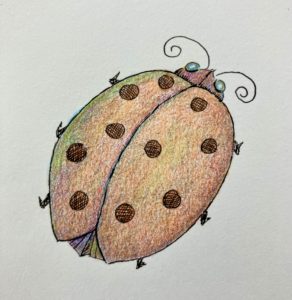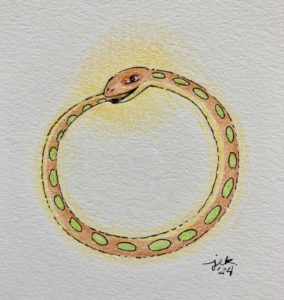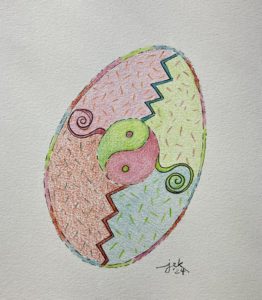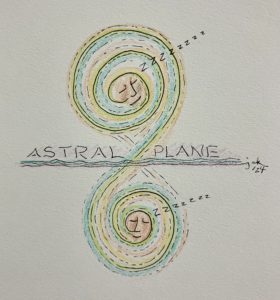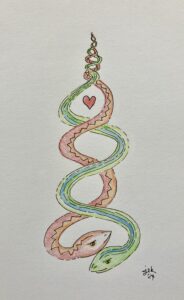
-Artwork © 2024 Jan Ketchel
This much I got right from my second grade religious instruction: God is everywhere. God is everything. Nothing that is, is not God. God is, simply, All That Is. Everything and everyone in our world is part of All That Is. We are all one. All includes both good and evil, in everyone.
We are a holographic universe. Shine a light on any one of us and all of us will appear. As within, so without. As above, so below. Our supposed individuality is simply what we emphasize in All That Is. Though we may emphasize the good, we are all equally, latently evil.
When we rigidly identify with the good, we project our evil outwardly, where someone else must vicariously live that side of our wholeness for us. This is the stalemate of extreme polarization: We hate our disowned shadows yet remain hopelessly, negatively bound to them, as they reflect in the faces of our supposed enemy.
To become whole beings we must include all that we truly are. Our personal drama for the life we are in reflects our attempt to reconcile the particular constellation of All That Is that we chose to experience in this lifetime. The ideal is a union of all our discordant parts into a balance that best serves the greater good.
Truthfully, sometimes the balance achieved is extremely volatile and destructive, as is quite evident in the greater world, particularly in America this very day. Nonetheless, for all of its unsettledness, our current world is fully an equal member of All That Is: All With Equanimity (AWE).
This wholeness does not mean that boundaries and limits are not to be exercised. As the Dalai Lama once answered when questioned, yes, he would use a gun to stop another from killing him. His caveat, however, was that he would not shoot in anger but with total loving compassion for the person trying to assassinate him.
To love everyone, we must begin with ourselves. We are tasked with loving every aspect of ourselves, even the body parts that we try so hard to hide. We must even love the part of ourselves that hates and judges ourselves and others. We must love that part of All That Is. Through loving that part we bring better stability into the dream we are in.
Can we love the greedy, unforgiving, entitled, self-serving, bitter part of ourselves that seeks release through vengeance and retribution? Can we allow ourselves to know and accept that part of our being that is so consciously rejected and buried alive within?
Can we love the mercenary, deceiving, selfish, power hungry materialist within that we dress over with generosity and random acts of kindness? To face the truth of, and love this part of self, we must remove its stigma and find its rightful home within, refining the personality to reflect its greater wholeness in better balance.
Outwardly, we are tasked to reclaim ownership of the parts of ourselves that we project onto others, those whom trigger us to rage and embroil us in a battle of opposites. Can we have compassion, even feel gratitude, for those who play such a vital mirroring role in our own journey of self discovery?
And yes, we may need to stop them or ignore them, but can we do it from a place of love versus hate? When we hate, we reject a vital part of All That Is. Short of full acceptance, that which we hate becomes our karma and our destiny.
When we can be in love, we raise our energetic vibration to a frequency that gives us direct access to our subconscious mind. The neural networks in our brain expand with harmonious neuroplasticity, as our emotions are elevated and calmed with in-body dopamine and serotonin.
Our brainwaves flow cohesively as our thoughts are calm and collected. Outwardly, we manifest positive vibrations that invite greater social cohesion. Even when all opportunity for outer connection is denied, we rest contentedly within, knowing that all things will pass.
I am particularly grateful to be able to participate in the leela, or Divine play, of now. I hold all epochs in AWE, but truly appreciate the unique opportunity of now, in this Age of Aquarius, to refine love to such subtle levels, as we manifest the next stage of our evolving dream.
With love and gratitude,
Chuck
*NOTE: I threw the I Ching, asking for a reading for America with respect to the outcome of the election today. I decided to suspend interpretation but share the hexagrams obtained, for review by anyone interested: Hexagram #12, Standstill, with the 9 in the 5th place highlighted. The future of this reading is #35, Progress. Do be sure to explore the 9 in the 5th place, which is the key to the whole reading. There are many I Ching interpretations, including the classic Wilhelm translation. A search online will reveal many options.

